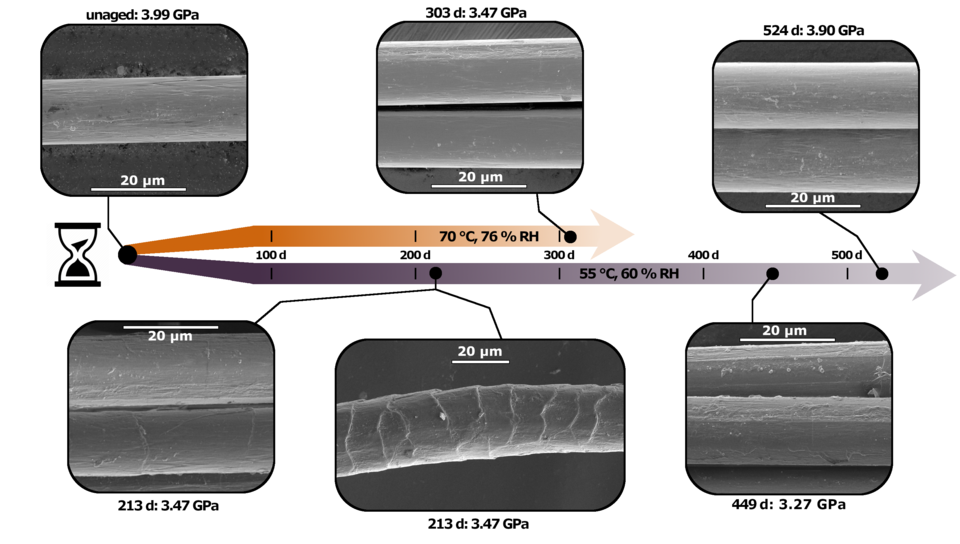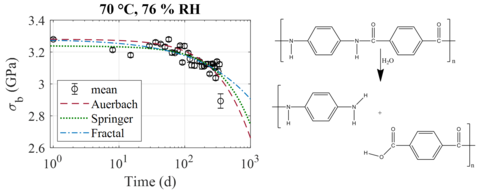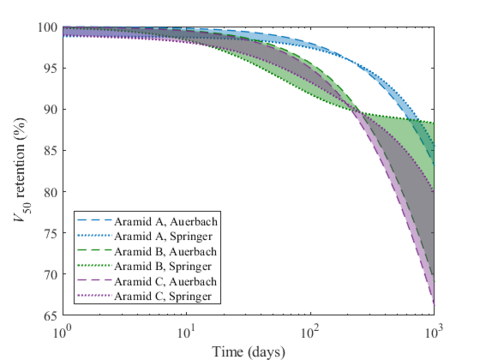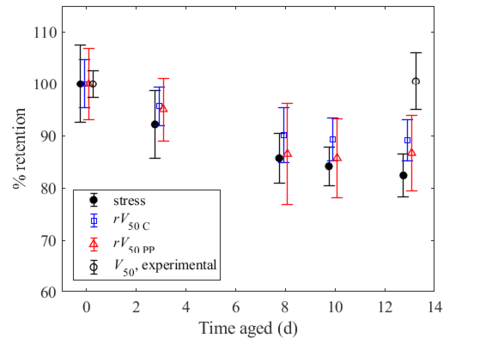Summary
High-strength materials are used to protect wearers from injury due to ballistic and stab threats, as well as other potentially life-threatening incidents. The mechanical behavior necessary to prevent injury from these threats is multifaceted and dependent on the chemical and structural properties of these materials. The Security Technologies Group develops the measurement science necessary to understand the chemical and structural properties of these materials and how these properties are affected by environmental exposure and wear.
Description

The body-armor community generally bases armor design on empirical models that do not directly relate molecular properties to performance. Aramid, aramid copolymers, and polyethylene fibers are highly oriented, anisotropic fibers that require specialized characterization techniques. In addition, there has historically been limited publicly available data on degradation mechanisms in these materials. Fundamental understanding of the impact of material properties on short and long-term material performance is limited by this lack of available data. Also, interacting factors (e.g., kink band formation) have not been considered in the context of broader performance degradation.
The STG conducts and performs fundamental research to advance the understanding of these high-strength materials, which can be challenging to study. The goal of this work is to enhance the body armor community’s understanding of the relationship between properties and performance in high performance materials used in protective applications. This work falls under three primary project areas which include elucidating mechanisms of ageing of high strength fibers and their impact on material properties, the development of novel measurement tools and procedures to examine structure-property relationships in high strength materials, and the advancement of understanding in the links between quasi-static material properties and ballistic performance.
Elucidating mechanisms of ageing of high strength fibers and their impact on material properties has been a major focus area of this project in recent years. Many different forms of high strength materials, including fibers, yarns, tapes, and unidirectional laminates are being studied through carefully controlled artificial aging experiments to understand the effects of elevated temperature and humidity on these materials (Figure 2). Aramids, copolymer aramids, and ultrahigh molar mass polyethylene are all studied through this program. In addition to extensive publications in recent years (see below) we have also focused on archiving material properties data to assist others within the community (see data publications below).

An overall goal of our work is to advance the understanding of links between quasi-static material properties and ballistic performance. Using established theoretical models, we predict the reductions in ballistic performance that can be expected with aging (Figure 3). A forthcoming publication (currently in press) will compare these predictions with experimental ballistic properties measurements for aged and unaged materials, as shown in Figure 4. While these established models work well for linear elastic materials, they do not correctly predict ballistic properties or nonlinear elastic materials. Examining this phenomenon and proposing modifications to these models will be a major focus of our work in coming years, since nonlinear elastic materials are becoming more commonly used in protective applications.

Novel measurement tools and procedures for high strength materials are necessary to study these materials, which can present unique challenges in mounting, gripping, and other aspects of mechanical testing. We strive to share our efforts to develop robust characterization methods by publishing papers and videos to fully describe our experimental techniques, grip designs, and instrumentation development and by participating in relevant standards bodies to further disseminate our efforts in this area to the high strength material community.

Major Accomplishments
Project Publications
2020
Linking Theory to Practice: Predicting Ballistic Performance from Mechanical Properties of Aged Body Armor (Journal of Research of NIST)
Effects of temperature and humidity on high-strength p-aramid fibers used in body armor (Textile Research Journal)
Effect of elevated temperature and humidity on fibers based on 5-amino-2-(p-aminophenyl) benzimidazole (PBIA) (SN Applied Sciences)
Tensile testing of aged flexible unidirectional composite laminates for body armor (Journal of Materials Science)
2019
A New Method for Tensile Testing UHMMPE Single Fibers at High Temperatures and Strain-rates (NISTIR)
Cutting procedures, tensile testing, and ageing of flexible unidirectional composite laminates (Journal of Visualized Experiments)
2018
Oxidation reactions in kink banded regions of UHMMPE fiber-based laminates used in body armor: A mechanistic study (Polymer Degradation and Stability)
Disentangling high strength copolymer aramid fibers to enable the determination of their mechanical properties (Journal of Visualized Experiments)
Data Publications
Datasets associated with many of the publications above have been made publicly available.
Ageing of High Strength p-Aramid Fibers Used in Body Armor (NIST Public Data Repository)
Aged and unaged PBIA-based copolymer testing for soft body armor applications (NIST public data repository)
Aged and unaged flexible unidirectional composite laminate tensile testing for soft body armor applications (NIST public data repository)
Effect of temperature and strain rate on ultra high molar mass polyethylene (UHMMPE) fibers (NIST public data repository)

